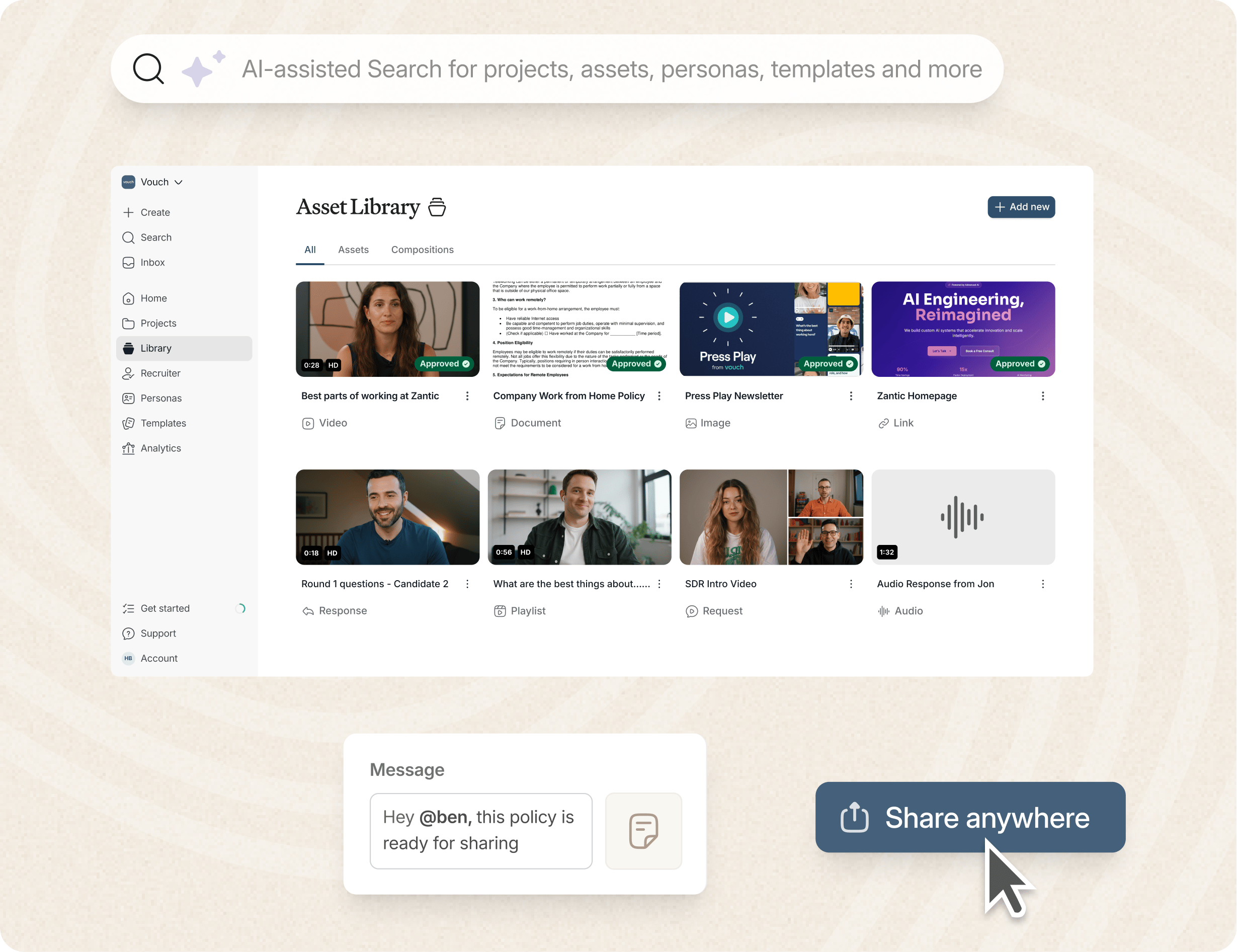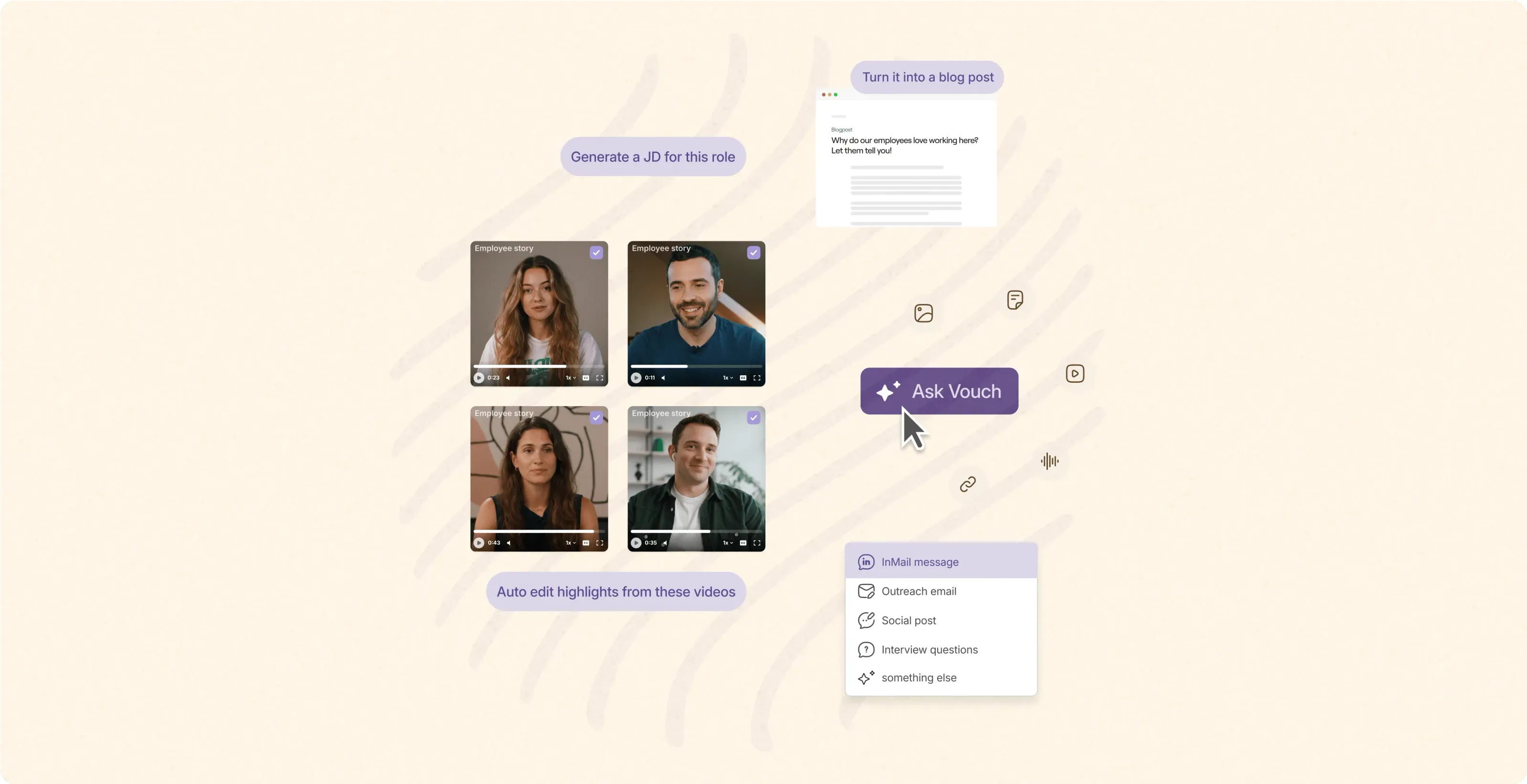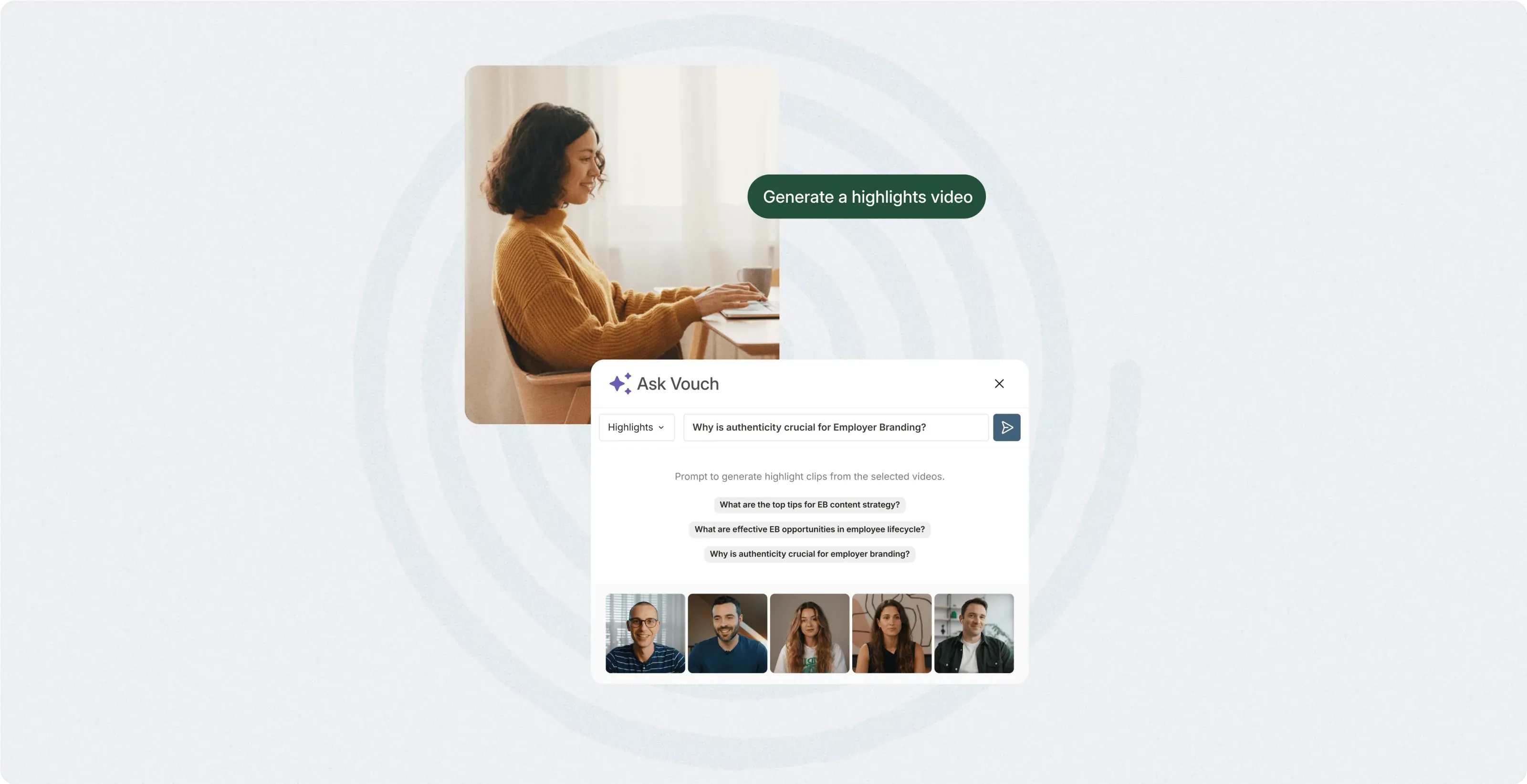
Personalized, Persuasive, People-Forward: The Vouch Guide to Using Video at Every Stage of the Employee Lifecycle - Part 1: Employer Brand
Welcome to our seven-part blog series: Personalized, Persuasive, People-Forward: The Vouch Guide to Using Video at Every Stage of the Employee Lifecycle.
In this series, we’ll take a deep dive into how businesses can harness the power of personalized, employee-generated video to drive engagement, enhance recruitment, improve onboarding, and foster ongoing employee development.
Each part focuses on a critical stage of the employee lifecycle, exploring actionable strategies and real-life examples of how to put people at the center of your communication strategy.
As we navigate through the rapidly changing landscape of workforce expectations and media consumption habits, we’ll show you how platforms like Vouch can empower companies to create content that’s not just informative but also authentic, engaging, and impactful. We’ll explore how video can transform everything from employer branding and recruitment to learning and development.
This series will be broken down into the following parts:
1. Employer Brand
3. Pre-boarding and Onboarding
By the end of this journey, you’ll have a roadmap for using video at every touchpoint of the employee lifecycle, making your communications more personalized, persuasive, and people-forward. Let’s get started!
Zoom out: what you’re seeing is a generational transformation.
Think about the differences between the people leading today’s businesses and those who are only just entering the workforce.
Someone in the C-suite today is likely to be in their late 40s or early 50s. They graduated from college in the mid-1990s. When they started working, they may have been combing through job listings printed in their local newspaper. They were beginning their working life at a moment when many people spent their entire careers with one company.
Fast-forward 25 years. What’s changed?
Well, the internet. But if you look beyond the obvious, you’ll see the collision of two massive trends:
- People no longer spend their entire careers in one place: In a recent article for Business News Daily, a former HR leader from Oracle says, “Research suggests that today’s college graduates will have a dozen or more jobs by the time they hit their 30s.” Businesses can no longer expect their employees to stick around for 30 years — they’ll be lucky if they’re still there after 30 months. Employee turnover is on the rise, and fostering employee engagement and retention can be a massive factor for organizations in competitive industries.
- The way jobseekers consume information has changed: For the generation entering the workforce today, their entire high school and university experiences were shaped by social media. They documented their lives on Instagram and Twitter, watched user-generated videos on YouTube, and discovered new trends and influencers on TikTok. And with each new platform, the content itself got shorter and shorter — TikTok, YouTube Shorts and Instagram Reels all command viewers’ attention with videos that are only a few seconds long.
We’re not just talking about the gap between the baby boomers in the C-suite and the members of Gen Z applying for roles. There’s even a difference in mindset between young candidates and the hiring managers or people leaders tasked with recruiting them. These generations grew up with different media diets, technology habits, and career expectations — and those differences can show up in significant ways.
The way companies communicate with potential hires and employees needs to change and change quickly.
What makes platforms like TikTok and Instagram so appealing to the newest generation of employees and jobseekers? Above all, these social media platforms deliver content that’s personalized, persuasive, and people-forward:
- Personalized: Content is served according to mountains of user data, ensuring that users are continuously shown what they want to see, when they want to see it. No two user experiences are alike; instead, each user is presented with a one-of-a-kind collection of content tailored to their interests.
- Persuasive: Those ultra-precise content feeds don’t just serve to keep users interested — they’re also incredibly effective at influencing their behavior. TikTok has helped products ranging from Stanley water cups to Birkenstock shoes go viral and spike in sales. We can easily draw a direct line from user-generated content to real actions from viewers.
- People-forward: Why do we find this content so engaging? Because it puts real people at the center. Any user can theoretically speak directly to their smartphone camera and start building a following. There’s no film crew required — social media audiences can be built around authenticity (or at least the appearance of authenticity).
Today’s businesses recognize the need to liven up their employer brand and become more approachable. But creating social media content just to recruit new employees is a short-term fix to a long-term problem. To overcome the colliding challenges of changing media diets and decreasing employee loyalty, companies need to learn the most important lessons from user-generated content and deploy them at every stage of the employee lifecycle.
This guide will explain how.
We’ve brought together our best practices on how to use Vouch — a user-friendly platform for collecting, editing and distributing employee-generated video content — throughout the employee lifecycle, from recruiting to onboarding to learning and development and team alignment. We’ve also sourced examples from real Vouch customers — globally recognized organizations that are gaining traction by putting employees at the center of their communications.
This guide offers a straightforward, easy-to-follow roadmap for a more personalized, people-forward employee experience — leading directly to more effective recruitment and stronger employee retention.
Let’s get started.
Part 1: Employer Brand
What is it like to work for your company? What do people envision when they think about applying for a job? That’s your employer brand.
Historically, large organizations have invested huge budgets into creating a pristine employer brand — carefully calibrated to appeal to as many people as possible. They’ve spent tens of thousands of dollars on recruitment videos that highlight the company’s important mission, its diverse workforce, and its ironclad values.
A traditional employer brand often focuses on the company’s leaders: the executives — the CEO in particular — who chart the course for the organization and set the tone for the employee experience.
Are you starting to see the problem? This one-size-fits-all, top-down approach to an employer brand isn’t personalized, it’s rarely persuasive, and it’s anything but people-forward.
Businesses can quickly correct for these issues by enabling employees to create their own content. Tools like Vouch allow HR teams and people leaders to send prompts and questions to their employees; each individual employee can then record their own responses, providing the requester with a library of content that can be deployed to enhance and bring authenticity to the employer brand.
Why is this individual, targeted approach more effective?
For one thing, it makes the employer brand much more personal. When a global company records an expensive, highly-produced recruiting video, they’re not able to differentiate between the different roles they’re recruiting for. They’re not even able to differentiate between different locations — they’re deploying the same video regardless of whether the candidate is applying for Chicago or Copenhagen.
The distributed, personal approach to collecting employer brand videos ensures that you can cover all your bases: you can request responses from employees at every location and at every level of the organization. Regardless of what role you’re hiring for, you’ll have content on hand that’s relevant to the applicant.
The targeted approach to employer branding is also more authentic, which in turn makes it more persuasive. Requesting individual, employee-generated responses to relevant questions ensures that you’ll get an authentic answer with a real team member as the star.
Three prompts to drive strong employer brand content:
- What do you enjoy most about working at ______?
- Why did you choose ______ over other opportunities?
- What excites you most about the future at ______?
For some companies, this shift in content creation can be scary — giving up careful control over the narrative and content creation process. But it’s important to remember that employees will be responding to your prompts and won’t be posting directly to your company channels. Your HR, employer brand or content teams still have the chance to review and curate the content before publishing it to the world. Ultimately, storytelling is still in your hands.
The AI-enabled workspace for talent teams.
- Unified workspace for talent teams
- Accelerate hiring with AI tools
- Auto-generate polished hiring and employer brand content
- Easily repurpose assets across all channel

Don’t forget to keep an eye out for the next installment, where we’ll dive deeper into how recruitment and hiring can be transformed with the power of employee-led video content. Whether you’re looking to differentiate your job postings or boost candidate engagement, the next post will offer strategies that can give your recruitment process the edge it needs.
You might also like

Elevate Your Brand Today With Vouch
Discover how Vouch can accelerate talent acquisition while helping you stay on-brand.





